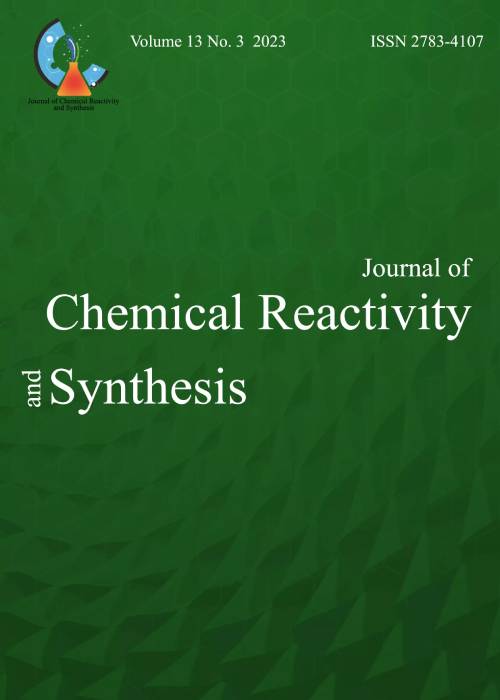فهرست مطالب
Journal of Chemical Reactivity and Synthesis
Volume:12 Issue: 2, Spring 2022
- تاریخ انتشار: 1401/03/11
- تعداد عناوین: 6
-
Pages 82-90
The aim of present studies is to focus on the structural optimization and thermodynamic properties of some 4-aryl-imidazolidin-2,5-diones (IMs) by using density functional theory (DFT). The collected data showed that the substitution on the aryl ring can be effective on the thermodynamic properties.
Keywords: Imidazolidin-2, 5-dione, Thermodynamic, density functional theory, Substitution -
Pages 91-99
The protonation constants of valin (K1 and K2) was determined in binary mixtures of water with dimethylsulfoxide containing (0, 10, 20, 30, 40, and 50) % (v/v) using a combination of potentiometric method at 25 °C and constant ionic strength (0.1mol ·dm-3 sodium perchlorate). The protonation constants were analyzed using the normalized polarityparameter (ETN) and Kamlet, Abboud, and Taft (KAT) parameters. A very good linear correlation of log K versus the normalized polarity parameter was obtained. Dual-parameter correlation of log K versus π*(dipolarity/polarizability) and R (hydrogen-bond donor acidity) as well as π* and (hydrogen-bond acceptor basicity) also gives good results in various aqueous organic solvent mixtures. Finally, the results are discussed in terms of the effect of the solvent on the protonation constants.
Keywords: solvent effect, valine, Tautomeric, Dissociation Constant, Dimethylsulfoxide -
Pages 100-109
Low-cost activated carbon was prepared from Pterocarya fraxinifolia. To determine the adsorption process the effects of various operating parameters, initial concentration of metal ions (50–200 mg/L) and temperature (298–328 K) were investigated in a batch adsorption technique. Equilibrium data were analyzed by the Langmuir and Freundlich isotherm model. Langmuir and Freundlich isotherms provided the best fit to the equilibrium data and maximum adsorption capacity of 370.370 mg/g at 298 K. The thermodynamic parameters, such as Gibb’s free energy change (ΔG), standard enthalpy changes (ΔH) and standard entropy change (ΔS) was evaluated. The value of ΔG was found negative for the adsorption of Pb (II) which confirmed the feasibility and spontaneity of the adsorption process.
Keywords: Pterocarya Fraxinifolia, Isotherm, Thermodynamic, Pb (II), Equilibrium -
Pages 110-117Reaction of 2, 3- dichlroquinoxaline with hydrazine in methanol at room temperature gave 1-(2-chloroquinoxalin-3-yl) hydrazine and after 24 hours. Condensation of 1-(2-chloroquinoxalin-3-yl) hydrazine with ethylorthoesters on their boiling carboxylic acids for 8 hours afforded a group of 4-Chloro- [1,2,4] triazolo[4, 3- a]quinoxaline derivatives. Stirring of 4-Chloro- [1,2,4]triazolo[4, 3- a]quinoxaline derivatives with amines for 2 hours in ethanol at room temperature afforded a group of 4-Amino- [1,2,4]triazolo[4, 3-a]quinoxaline derivatives. Solvent effect of methanol and chloroform on this reaction and the spectral data is discussed.Keywords: 2, 3- dichloroquinoxaline, [1, 2, 4]triazolo[4, 3- a]quinoxaline, orthoesters
-
Pages 118-125
In this study a new method for electrocatalytic oxidation and determination of ascorbic acid (AA) was developed. The proposed electrode was a zeolite-modified carbon paste electrode, which was doped with Ni (II) ions (Ni2+Y/ZMCPE). Ni (II) ions were doped in Y-zeolite framework by ion-exchange mechanism and actd as catalyst to oxidize ascorbic acid. Then, electrocatalytic oxidation of ascorbic acid, using cyclic voltammetry and chronoamperometry techniques was investigated. The diffusion coefficient and current density of ascorbic acid were calculated as 1.491×10-4 cm2 s−1 and 5.17×103 respectively. A linear dynamic range for determination of ascorbic acid and detection limit using proposed modified electrode were 0.02– 4.10 mmolL−1 and 2.8×10−6mol L−1 respectively.
Keywords: Voltammetry, Ascorbic acid, Electrooxidation, zeolite, Modified electrode -
Pages 126-137In recent years, with the increase in the growing speed of industries and population, water pollution and environmental pollution is a major challenge for the scientific community, which needs a serious and real solution in the world. Because the discharge of wastewater containing toxic substances, solid waste or flue gases from factories is known as a serious problem for the sustainable development of human society. Therefore, in this paper, which is a review of recent studies on this subject, first, an introduction to the catalytic degradation of pollutants is provided, and then the researcher's studies are reviewed, and finally, a conclusion is provided. In conclusion, it is found that in photocatalytic processes, the catalyst dosage is very effective on the rate of pollutant degradation. As the catalyst dosage increases, the number of active sites absorbing the pollutant at the catalyst surface also increases. The increasing trend of dye removal with catalyst dosage can be attributed to the increase in surface area and the availability of more absorption sites. This process continues until it increases light absorption and the production of hydroxyl radicals. However, it is also noteworthy that at values above the optimum, the reaction rate decreases. In other words, if the catalyst dosage is too high, not only it is not effective on the dye removal process, but also causes more turbidity of the solution, which in turn prevents the penetration of light and the effectiveness of the photocatalytic process.Keywords: Synthesis, Photocatalyst, Organic pollutants, wastewater


